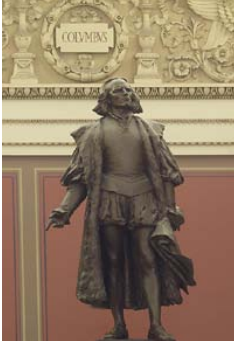The Library of Congress is the world’s largest repository of knowledge and creativity, with a growing collection of more than 150 million items, including books, print materials, sound recordings, photographs, maps, sheet music, motion pictures, and manuscripts. Although books are the heart of the Library, from the volumes of American statesman Thomas Jefferson to the most current material that reflects contemporary culture, there is much more. The Library supports research in its Main Reading Room and in twenty-one specialty reading rooms; archives millions of priceless objects, including the papers of key figures from around the world; gives a stage to performances of all kinds; creates exhibitions that explore historic and cultural themes; produces a wide range of books and teaching materials; and is a global leader in the science of preservation and information management.
The Library of Congress was established in 1800, when President John Adams signed a bill transferring the seat of the U.S. government to Washington. The legislation described a library of “such books as may be necessary for the use of Congress.” The initial collection of 740 books and 3 maps was housed in the new Capitol Building until August 1814, when invading British troops burned the building, destroying the small library.
President Thomas Jefferson, then retired and living at Monticello, offered his personal library as a replacement. In January 1815, Congress appropriated $23,950 to purchase Jefferson’s collection of 6,487 books, and thereby laid the foundation for a great national library. The Jeffersonian belief that all subjects are important to the American legislature is the philosophy that inspires the comprehensive collecting policies of today’s Library of Congress. The Thomas Jefferson Library exhibition is on view on the second floor.
Facing a shortage of space in the Capitol and concerned about the safety of the collection after two disastrous fires, Congress approved the construction of a separate building for its Library. Opened on November 1, 1897, the new “Congressional Library” was hailed as a glorious national monument. In 1980, the building was named for Thomas Jefferson in honor of his role in the Library’s history. Between 1984 and 1997, the building was restored to its original nineteenth-century splendor.
Located in the heart of the nation’s capital, The Library of Congress stands out in many regards, but none as noticeable as its immense size. It is the single largest library in the world, “with more than 130 million items on approximately 530 miles of bookshelves. The collections include more than 29 million books and other printed materials, 2.7 million recordings, 12 million photographs, 4.8 million maps, and 58 million manuscripts.”
“It was hailed as a glorious national monument and ‘the largest, the costliest, and the safest’ library building in the world.”
The Library of Congress functions as a branch of the United States government. It is the principal library for the legislative body, though it does duty as a public library as well. Though books may only be used on site, unless by a member of the United States Congress, it is open to anyone above high school age without payment or special permission and it bills itself as “the world's largest library and a great resource to scholars and researchers.” The library is comprised of several divisions including, the Office of the Librarian, Congressional Research Service, U. S.Copyright Office, Law Library of Congress, Office of Strategic Initiatives and Library Services.


























0 comments:
Post a Comment